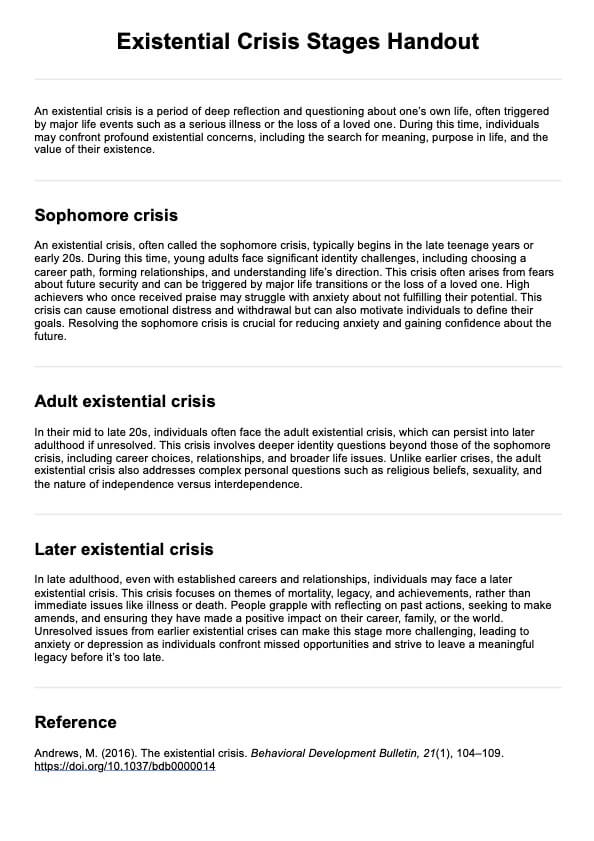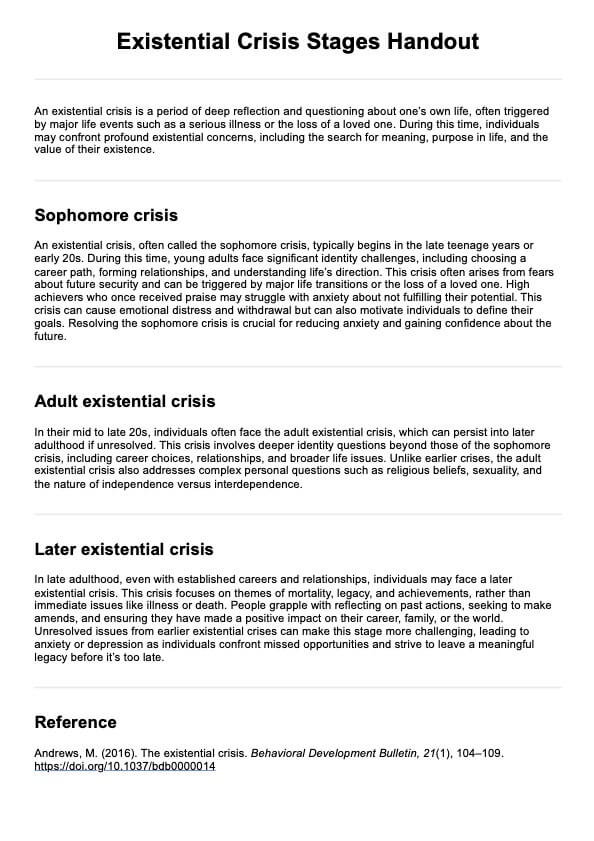Existential Crisis Stages Handout
Understand the different stages of an existential crisis and learn how to navigate them with Carepatron's free PDF download.


What is an existential crisis?
An existential crisis is a period of deep reflection and questioning about one’s own life, often triggered by major life events. This can range from a promotion, a huge life transition to a serious illness, or the loss of a loved one. During this time, individuals may confront profound existential concerns, including the search for meaning, purpose in life, and the value of their existence. This intense introspection can lead to feelings of existential dread, existential anxiety, and even existential depression as individuals grapple with the idea of living a meaningless life.
For many, an existential crisis represents a turning point that prompts growth and pursuing a more meaningful life. However, this process can also be overwhelming, sometimes resulting in other mental health issues, including suicidal thoughts. In later life crisis scenarios, these feelings may be particularly acute as individuals reflect on the passage of time and their accomplishments.
Existential Crisis Stages Handout Template
Existential Crisis Stages Handout Example
Stages of Existential Crisis
An existential crisis can occur at various stages of a person's life, often triggered by significant changes or challenges. Though distinct in their timing and context, these crises share common themes of existential dread, existential anxiety, and the search for an authentic life.
Sophomore crisis
An existential crisis, often called the sophomore crisis, typically begins in the late teenage years or early 20s. During this time, young adults face significant identity challenges, including choosing a career path, forming relationships, and understanding life’s direction. This crisis often arises from fears about future security. Resolving the sophomore crisis is crucial for reducing anxiety and gaining confidence about the future.
Adult existential crisis
In their mid to late 20s, individuals often face the adult existential crisis, which can persist into later adulthood if unresolved. This crisis involves deeper identity questions beyond those of the sophomore crisis, including career choices, relationships, and broader life issues. Unlike earlier crises, the adult existential crisis also addresses complex personal questions such as religious beliefs, sexuality, and the nature of independence versus interdependence.
Later existential crisis
In late adulthood, even with established careers and relationships, individuals may face a later existential crisis. Unresolved issues from earlier existential crises can make this stage more challenging, leading to anxiety or depression as individuals confront missed opportunities and strive to leave a meaningful legacy before it’s too late.
How does our Existential Crisis Stages Handout template work?
Our Existential Crisis Stages Handout template is a valuable tool designed to assist medical professionals in guiding their clients through the various stages of an existential crisis. Here's our handout can work:
Step 1: Understanding the structure
The handout is divided into sections corresponding to each stage of an existential crisis—sophomore crisis, adult existential crisis, and later existential crisis. Each section includes a brief overview of the specific stage, highlighting its common challenges and associated feelings. This structured approach allows medical professionals to quickly identify the stage their client is in and tailor their guidance accordingly.
Step 2: Assessing the client’s stage
The first practical step in using the handout is to assess which stage of existential crisis the client is currently experiencing. The handout provides key indicators and symptoms associated with each stage, helping professionals assess accurately. This step is crucial as it sets the foundation for the entire treatment plan.
Step 3: Providing targeted information
Once the client’s stage is identified, the handout offers targeted information on common feelings, thoughts, and behaviors linked to that specific stage. This information is presented in a way that is easy for clients to understand, helping them recognize their experiences as part of a broader pattern. This can then be an opener for deeper discussion about their experiences and concerns.
How can clients cope with existential crises?
While existential crises can be challenging, they also present opportunities for personal growth and self-discovery. Here are some effective strategies clients can use to navigate and cope with existential crises:
- Acknowledge and accept the experience: The first step in coping with an existential crisis is recognizing and accepting it. Encourage clients to validate their feelings and thoughts without judgment.
- Engage in self-reflection: Promote self-reflection through meditation, writing a gratitude journal, or contemplative practices. These activities can help clients gain clarity about their values, beliefs, and aspirations.
- Seek connection and support: Remind clients that they're not alone in their experience. Encourage them to reach out to trusted friends, family members, or support groups. Sharing thoughts and feelings with others can provide comfort and new perspectives.
- Explore meaning-making activities: Engage clients in activities that foster a sense of meaning and purpose. This could involve volunteering, pursuing creative endeavors, or engaging in spiritual practices.
- Practice mindfulness: Introduce mindfulness techniques to help clients stay grounded in the present moment. Mindfulness can reduce rumination on existential concerns and promote acceptance of uncertainty.
Benefits of using our Existential Crisis Stages Handout
Using Carepatron's Existential Crisis Stages Handout offers several significant benefits for medical professionals when guiding patients through the challenging process of experiencing an existential crisis. Such benefits are:
Facilitates clear understanding of the patient's inner conflicts
The handout helps medical professionals identify and address the inner conflicts that patients may face during an existential crisis. By providing a clear framework for understanding the different stages, professionals can more easily pinpoint where a patient’s struggles, such as self-doubt or questioning the meaning of life, are originating.
Enhances patient engagement and personal growth
The handout also plays a crucial role in enhancing patient engagement by encouraging reflection on big life questions and their admirable qualities. It allows patients to explore their feelings and experiences, promoting self-awareness and growth.
Commonly asked questions
Individuals who are undergoing significant life changes, such as major life events, or those with a tendency toward introspection may be more prone to experiencing an existential crisis. People dealing with stress, trauma, or mental health issues are also at a higher risk.
An existential crisis can vary in duration, lasting anywhere from a few days to several months, depending on the individual's circumstances and coping mechanisms. Seeking professional support and engaging in reflective practices can help shorten the duration and alleviate the associated distress.
Existential anxiety may lessen over time, especially with the right coping strategies and support, but it can recur during different stages of life. Ongoing self-reflection, therapy, and cultivating a sense of purpose can help manage and reduce these feelings.




















-template.jpg)



















































































